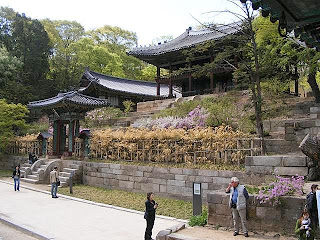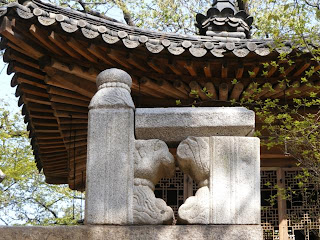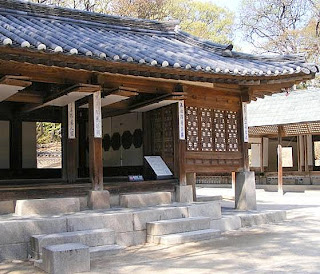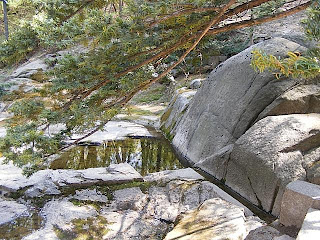The question mark in the title stands for the names of this garden, during the time: The North Garden, The Forbidden Garden or the Secret Garden? The last one is not very much liked by the authorities (as I read in a guide book), so the official name is Biwon Garden.
The number of people visiting the garden is kept under control, in order to preserve this natural beauty. This is the reason you may not visit it alone. Korean landscaping is using everything the nature is offering: trees, rocks, streams, and include them in their parks, which seem very natural. The Biwon Garden is considered the climax of the Korean gardens.
Only the royal family had the right to use the garden. They relaxed in the beautiful pavilions, drank wine, wrote poetry, attended little banquets. Men organized also archery contests here.
The first place we stopped is the area of Buyongji Pond. The square format of the pond represents the Earth and the small round island represents the Universe. Some nice pavilions and a two levels building are near the pond. In the big building it was kept the Gyujanggak’s library. This was a kind of research institute for politics to sustain the king’s reforms. It was erected in 1776.
During the second stop we visited the Yeongyeongdang complex, built in 1828 and reconstructed in 1865. The model has been the litterati house. There were separate apartments for kings and queens. The foliage of the trees around the complex, suggested the beauty of the forest during the autumn. Like in Japan, Korea has a special tourism which favours watching the colors of nature: in the spring, when cherries are blooming and in the autumn, when leaves turn their colors.
Aeryeonji Pond was another stop on our visit. Some small pavilions, one in the form of an open fan, and one dating from 1644, Jondeokjeong, where also used for royal relaxation.
Then we stopped once more to see the Ongnyucheon Stream, an artificial waterway, were kings wrote poetry, inspired by nature.
On our way toward the exit we admired a 750 old juniper, older than the palace itself. The aromatic wood of the Chinese juniper is used in ancestral rituals.
Semnul de intrebare din titlu se refera la multele denumiri pe care le-a purtat aceasta gradina. Ea a fost denumita Gradina de Nord (Bugwon) si Gradina Interzisa (Geumwon), pentru ca in timpul domniei regelui Gojong sa i se spuna Biwon (Gradina Secreta), denumire, neagreata insa de oficialitati.
Gradina, considerata una dintre cele mai frumoase gradini tipic coreene, are trei zone principale de interes: cea din jurul iazului Buyongji, a iazului Aeryeonji si Ongnyucheon. Gradinile coreene folosesc toate elementele de peisaj existente: pante, stanci sau torenti, care devin parte din ele, interventia omului fiind minima. Pavilioanele sau iazurile construite, pun in evidenta peisajul, nu incearca sa il domine.
Familia regala folosea aceste locuri pentru relaxare prin citit, discutii sau meditatie. In pavilioane, se odihneau band ceai sau vin, scriind poezii sau facand caligrafie. De asemenea, regele sau printii organizau intreceri de tragere cu arcul si participau la diverse banchete organizate pentru inalte oficialitati sau rudele apropiate ale regelui.
Vizita se efectueaza in grup mare, de zeci de persoane, si dureaza o ora si jumatate. Ghida noastra poarta o umbreluta eleganta, din dantela neagra, pentru a se feri de soare. Poarta un hanbok traditional si vorbeste engleza fara accent. Are un mod bland dar ferm de a tine grupul impreuna, urmarind, totodata, sa se incadreze in timpul alocat.
Urcand intr-o panta usoara, ne indreptam spre prima zona de interes, cea a iazului Buyongji. Conform regulilor cosmogoniei coreene, iazul de forma patrata reprezinta Pamantul, iar insula mica, rotunda este intruchiparea Universului.
In jur, sunt cateva pavilioane infrumusetate de stralucirea dancheon-ului, iar cladirea mai mare,
cu doua etaje, numita Juhamnu, adapostea la primul etaj biblioteca Gyujanggak, iar la etajul al doilea, o sala de lectura. Gyujanggak a fost infiintata ca biblioteca si institut de cercetare pentru politici care sa sustina reformele regelui. Biblioteca a fost construita in 1776, anul urcarii pe tron a regelui Jeongjo. O pauza de 15 minute permite tuturor sa faca fotografii si sa exploreze locul.
Desi aleile pe care mergem sunt asfaltate, am tot timpul impresia ca ma aflu in padure, nu intr-o gradina. De altfel, se spune ca, in vechime, mai aparea pe aici cate un tigru sau leopard, fapt care nu ma mira data fiind pozitia orasului, inconjurat din toate partile de munti.
La popasul precedent, ghida ne-a atentionat ca cine doreste sa se intoarca fiindca crede ca nu va face fata plimbarii pe pantele, uneori scurte si repezi, sa o faca acum. Mai departe, intoarcerea nu mai este permisa, pentru ca turistul sa nu se rataceasca prin parc. Drumul nu mi se pare greu. Fiind multi turisti, viteza de inaintare este foarte diferita, asa ca iti poti regla cu usurinta pasul. Sunt turisti asiatici dar si europeni sau americani. O turista din Israel ma intreaba de unde sunt si, cand ii spun, exprima aprecieri la adresa Romaniei, spunand ca a vizitat timp de 10 zile Brasovul si Sibiul, care i-au placut mult.
Ne oprim apoi la un complex de apartamente ale regelui si reginei, construite in stilul caselor pentru intelectualii vremii, aflati la mare cinste. Prima constructie dateaza din 1828 si se datoreaza printului mostenitor Hyomyeong, care a organizat aici un ceremonial pentru tatal sau. In 1865, complexul Yeongyeongdang, cum se numeste, a fost reconstruit.
In fata sa se gaseste un alt iaz, cu lotusi, care acum nu sunt infloriti. In jurul sau, o multime de copaci cu frunze rosii, artari japonezi dar si alte specii pe care nu le cunosc, imi sugereaza cam cum trebuie sa arate padurea toamna! Ca si in Japonia si aici toamna padurile sunt vestite pentru coloritul lor, asigurand – alaturi de inflorirea ciresilor – un turism specific.
Apartamentele barbatilor sunt separate de cele ale femeilor. In fata lor se pot vedea mici blocuri de piatra, care serveau la incalecatul pe cal.
Printr-o mica poarta iesim iar in gradina-padure si ne indreptam spe iazul Aeryeonji. Acesta este cel mai spectaculos loc toamna, ne spune ghida. Cateva pavilioane adauga un farmec deosebit locului.
Pavilionul Gwallamjeong are o forma mai ciudata, de evantai deschis.
Sper ca vi-a placut si voua plimbarea prin aceasta gradina regala coreeana, care da o nota in plus Palatului Cheangdeokgung, cel mai frumos palat din Seul. Daca veti sta in capitala Coreei de Sud doar 2-3 zile, asigurati-va ca nu le veti rata!













































ce mi-ar place si mie sa ajung pe acolo..
daca iti doresti mult, ai sa ajungi:)
a wondeful impression,
nice to see this work.
greetings, Joop
Hi, Joop! Thanks for the visit and comment.
Greetings from Romania!
Another wonderful place but that first photo really stole the show.
such a beautiful and peaceful garden. you’re lucky enough to be able to visit this wonderful place. thanks for sharing your experiences.
do you like our guide or her hanbok and umbrella, Randy:)?
You are welcome, Life Ramblings. Yes, I was lucky, indeed.
Love the 9th picture, that’s beautiful. I’d love to spend some time in that type of environment!
Duncan In Kuantan
It will be a very relaxing time, Duncan, I can assure you!
I was already captured by the words ‘secret garden’, but after seeing these images I must say that this is much more than a garden and absolutely enchanting.
superba vegetatia!!
VP, you have no ideea how glad I am that I changed your opinion at a certain degree, and that you begin to find things you like!
E un loc absolut deosebit, Rocs! Stiau ei ce stiau…
I always enjoy your texts and pictures!
Glad to hear this, Phivos, thanks!
foarte frumoase gradinile coreene
Asa e, Apollo, ma bucur ca iti plac!